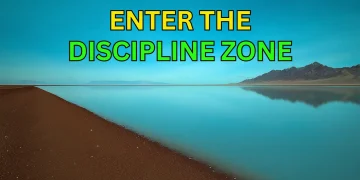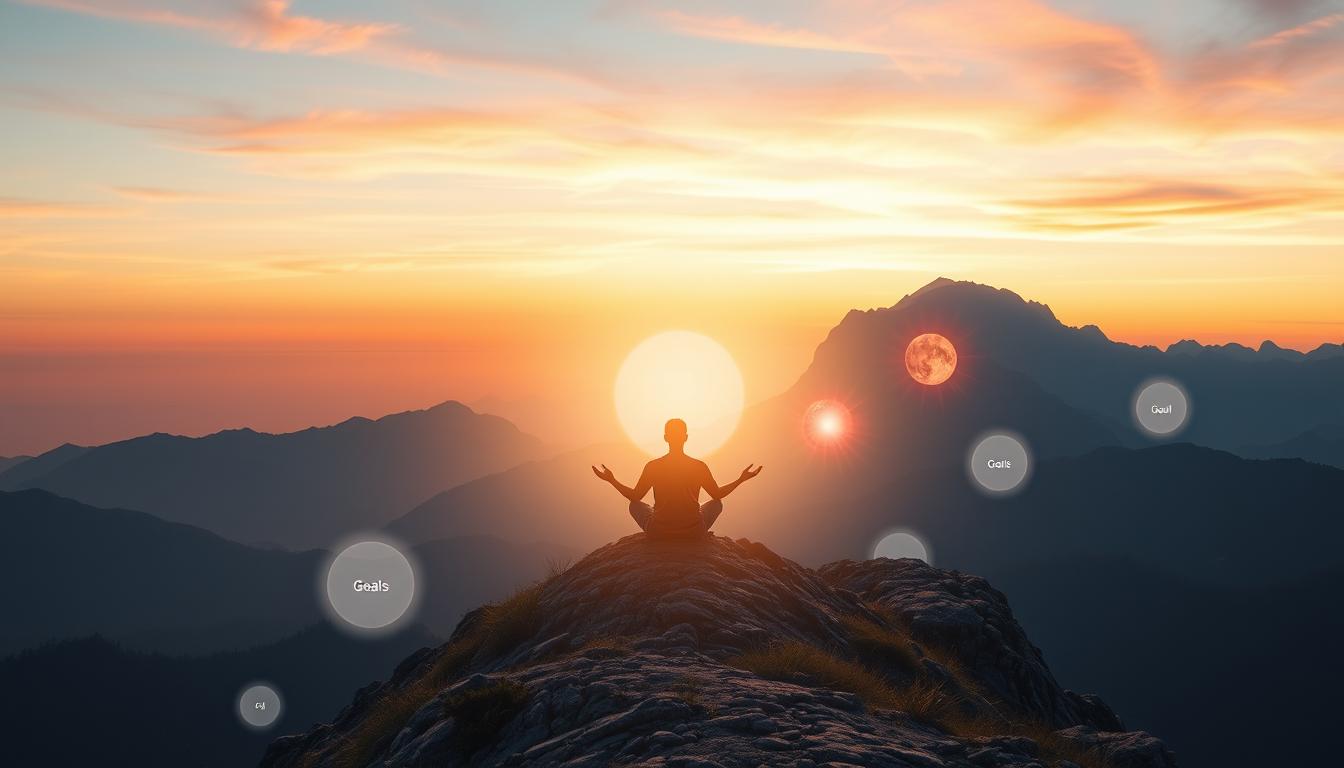“The future belongs to those who believe in the beauty of their dreams.” – Eleanor Roosevelt
Visualization is a key tool for setting goals and growing personally. It’s used by top athletes and entrepreneurs. By imagining your goals, you make them feel real and reachable. It uses all your senses, helping you make better choices, feel better mentally, and stay healthy.
This guide will show you how to use visualization to reach your dreams. It helps you break down big goals, adapt to new situations, and take steps towards your dreams. Whether you want to succeed in your career, get healthier, or build stronger relationships, visualization can help you grow and find happiness.
Key Takeaways
- Visualization is a highly effective goal-setting technique used by successful individuals across various fields.
- Incorporating all five senses when visualizing your goals can make them feel more tangible and attainable.
- Visualization can enhance decision-making, improve mental health, boost confidence, and promote healthier habits.
- Breaking down complex goals into smaller, actionable steps is crucial for successful visualization and goal achievement.
- Consistent practice of visualization, especially in the morning and before bedtime, can engage your subconscious mind towards your desired outcomes.
Understanding the Power of Visualization
Visualization is a powerful tool that uses your mind’s ability to create images. By imagining your goals, you activate the brain’s pathways as if you were doing it for real. This makes your goals feel more real and achievable.
What Makes Visualization Effective
Visualization works because it uses your senses like sight, sound, touch, and smell. When you vividly imagine achieving your goals, your brain thinks it’s happening. This can sharpen your focus, boost your motivation, and lower anxiety.
The Science Behind Mental Imagery
Research shows that visualization deeply affects your brain and body. Studies have found that imagining movements can train muscles almost as much as doing them. It also boosts performance, motivation, and reduces stress in many fields, from healthcare to law enforcement.
Breaking Down Complex Goals
Visualization is great for breaking down big goals into smaller steps. By imagining each action needed to reach your goals, you get a clear plan. This helps keep you focused on your big dreams, especially for ambitious or long-term goals.

“Visualization is the ability to imagine something vividly in your mind before it becomes a reality.”
Using visualization in your goal-setting can unlock your mind power, build a success mindset, and unlock your mental rehearsal potential. By using the science of mental imagery, you can improve your focus, motivation, and success.
The Role of Visualization in Achieving Your Goals
Visualization is key to reaching your goals by getting your mind ready for success. It helps align your thoughts and actions with your dreams. This makes it easier to face challenges and stay focused on your goals.
Positive visualization boosts your motivation, confidence, and focus. It makes you more likely to achieve your goals. It also lowers stress and anxiety, helping you relax and handle stress better. Plus, it sharpens your skills by improving your neural pathways.
Research shows that visualization is almost as good as actual practice in improving performance. Doing both mental and physical practices together is even better. Visualization enhances your attention, planning, memory, and motor skills, improving your overall well-being.
By setting goals and imagining achieving them, you’re on the right path. Visualization is essential for learning new skills and improving motor abilities in various activities. Adding this technique to your daily routine helps you stay on track and overcome obstacles.
“Positive visualization impacts motivation and goal attainment. Setting goals and visualizing their achievement is a key aspect of the necessary preparation to reach a desired outcome.”
Embracing visualization can change your life, helping you reach your goals and unlock your potential. It aligns your thoughts, emotions, and actions, guiding you to success with clarity, confidence, and resilience.

| Visualization Benefit | Supporting Evidence |
|---|---|
| Enhances motivation, confidence, and focus | Positive visualization has been shown to increase the likelihood of goal achievement. |
| Reduces stress and anxiety | Visualization techniques have been linked to stress reduction and anxiety alleviation. |
| Improves physical performance | Practicing a skill mentally through positive visualization can enhance actual performance. |
| Enhances overall well-being | Positive visualization has been associated with improved immune system function, better pain management, and overall well-being. |
Neurological Benefits of Visualization Practice
Visualization is incredibly powerful for reaching your goals. Studies show it has many neurological benefits. It uses your brain’s ability to imagine to improve your thinking and success.
Brain Activity During Visualization
Studies found that visualization uses the same brain areas as real seeing (Pearson et al., 2015). This means your brain acts like it’s really seeing what you imagine. This connection makes visualization great for improving cognitive enhancement and mental training.
Building New Neural Pathways
Visualization makes your brain’s connections stronger, creating new paths (Blackwell et al., 2019). This neuroplasticity helps you change your brain for success. By imagining your goals, you build a mental map to get there.
Enhanced Focus and Concentration
Visualization boosts your focus and concentration (Blackwell et al., 2019). It trains your mind to ignore distractions and focus on your goals. This helps you stay on track and overcome challenges.
Adding visualization to your daily routine can change your life. It unlocks mental training, flexibility, and problem-solving skills. These are key to reaching your highest potential.
“The power of visualization is that it creates a mental blueprint for your goals, making them more tangible and achievable.” – Unknown
Creating Your Personal Vision Board
Start your journey to success with a personal vision board. It’s a tool filled with images, words, and symbols of your dreams. It keeps your goals in sight every day, boosting your motivation.
Building your vision board is a special and empowering step. Think about what you really want, like a dream job or traveling the world. Collect pictures, magazine cutouts, and quotes that show what you aim for.
Make your vision board look amazing. It can be on a cork board or a digital collage on your phone. Place it somewhere you see it often to keep you focused.
Every day, let your vision board spark your senses and emotions. Picture yourself achieving your dreams. This mental practice can drive you to take action and make your dreams come true.
Find the vision board techniques that work best for you. Try different ways to make your vision board inspiring. Remember, it’s a personal reflection of your dreams. Let it motivate and guide you to reach your goals.
| Vision Board Benefits | Percentage |
|---|---|
| Increased Motivation | 37% |
| Improved Visualization | 23% |
| Higher Goal Achievement | 42% |
| Stronger Engagement | 65% |
| Better Retention | 80% |
“The act of creating a vision board is a fun and engaging way to explore your desires and aspirations.”
Incorporating the Five Senses in Goal Visualization
Goal visualization is more than just seeing the end result. It’s about using all five senses to make the experience real and engaging. By using sensory visualization and multisensory imagery, you can feel a stronger connection to your goals. This makes them seem more reachable.
Visual Elements and Mental Pictures
The visual part of goal visualization is key. It lets you create clear mental images of achieving your goals. Picture yourself doing well in a tough task, getting a promotion, or finishing a race. The more detailed these images, the stronger they can make you feel.
Auditory and Tactile Components
But vision is just the start. Add auditory and tactile elements too. Think of the sounds of success, like applause or a computer mouse click. Feel the sensations of your goals, like holding a trophy or feeling a loved one’s hug.
Emotional Connection Through Sensory Details
Using many senses helps you connect emotionally to your goals. Imagine the taste of a celebratory meal or the smell of fresh grass. These details can make you feel more positive and driven.
Adding the five senses to your goal visualization can change it from a simple mental exercise to a rich experience. Use the power of sensory visualization to unlock your immersive goal-setting potential.
Daily Visualization Techniques and Practices
Unlock the true power of visualization by adding it to your daily routine. Try guided imagery and mental movies of success. These can help you reach your goals and unlock your full potential.
Begin your day with a 10-minute miracle morning. Use this time to dream big and set clear goals. Imagine yourself achieving your dreams and feeling the joy of success. This practice trains your brain to see your dreams as real, making them more likely to happen.
Using affirmations is another great tool. Make positive statements that boost your confidence and repeat them all day. These affirmations can change your mindset, helping you move closer to your goals.
- Engage in guided imagery exercises that transport you to a peaceful, success-oriented state of mind.
- Create a mental movie of yourself accomplishing your objectives, complete with sensory details that bring it to life.
- Practice the Silver Linings exercise to cultivate an optimistic mindset and overcome challenges.
Consistency is key to unlocking visualization’s full benefits. Spend a few minutes each day on these practices. Soon, your dreams will start to become reality.
“Visualization is the act of creating a clear mental picture of what you want to achieve or experience in your life. It’s a powerful tool that can help you overcome obstacles and manifest your goals.”
Whether you want to boost your career, health, or relationships, these daily techniques can guide you. Use the power of your mind to unleash your true potential.
Combining Visualization with Action Steps
Reaching your goals is about mixing mental pictures with real steps. This mix boosts your success chances.
Creating Actionable Plans
Begin by breaking down your goals into doable tasks. Set deadlines, plan resources, and list the steps to make your dreams real. This plan will guide you and make sure your dreams match your actions.
Measuring Progress and Adjusting
Check your progress often and adjust when needed. Celebrate your wins and tweak your plan if you hit a roadblock. Progress tracking keeps you moving and helps you adjust your action planning for goal implementation.
Maintaining Momentum
Keeping motivated is key. Use visualization to stay inspired, especially when things get tough. Add daily visualization, check your vision board, and surround yourself with positivity. Staying consistent and dedicated will help you achieve your goals.
“Visualization is the magic wand of your mind. Use it to turn your dreams into reality.” – Marie Forleo
By blending visualization with solid action plans, you unlock your goal implementation potential. Stay on track, celebrate your wins, and let your dreams guide your action planning and progress tracking. Your mind’s eye is the first step to success.
Success Stories and Real-World Applications
Visualization is more than just a theory. It has been proven through many success stories. Top athletes, entrepreneurs, and leaders in personal development have used mental images to get amazing results.
Olympic gold medalist Michael Phelps is famous for his visualization. Before winning eight gold medals in the 2008 Beijing Olympics, he mentally rehearsed his races. This mental prep helped him succeed in the pool.
Oprah Winfrey, a huge influence, credits vision boards and affirmations for her success. She imagined her goals vividly, staying focused and motivated to achieve them.
- Carli Lloyd imagined scoring four goals before a game and got three, a World Cup first for a woman.
- Jim Carrey wrote a check for $10 million for acting in 1994. He earned that exact amount for “Dumb and Dumber.”
- Kerri Walsh and Misty May-Treanor, with three Olympic golds, use meditation, yoga, and visualization in their sports.
These visualization case studies, success examples, and goal achievement stories show how mental images can change performance and life. By using visualization, people from all backgrounds have reached their goals and achieved great things.
“The mind is everything. What you think, you become.” – Buddha
| Athlete | Visualization Technique | Outcome |
|---|---|---|
| Arnold Schwarzenegger | Visualization for bodybuilding and acting | Became a bodybuilding champion and successful actor |
| Lindsey Vonn | Visualizing race runs and simulating courses | Improved competitive performance as a skier |
| Will Smith | Positive thinking and visualization for success | Achieved fame and status as a Hollywood superstar |
The stories and real-world applications of visualization are inspiring. They show how the mind can help achieve goals. By using these techniques, you can unlock your potential and change your life in amazing ways.
Common Visualization Challenges and Solutions
Visualization can help you reach your goals, but it comes with its own set of challenges. You might face mental blocks, struggle to stay consistent, or need to adjust to new situations. But, with the right strategies and a flexible mindset, you can overcome these obstacles and fully benefit from visualization.
Overcoming Mental Blocks
Mental blocks can be a big challenge in visualization. Doubts and skepticism can slow you down. To get past these, try guided visualization techniques. They offer a structured way to practice. Also, consider working with a visualization coach or finding resources that help you stay positive and focused.
Maintaining Consistency
Staying consistent with visualization is crucial. It can be hard, especially with busy lives. To keep up, set reminders, have a special place for your sessions, and make it a must-do part of your day. Celebrate your small victories and adjust your routine as needed to stay committed.
Adapting to Changes
Your visualization practice needs to change as your goals and life do. Stay open to updating your mental images to match your life’s changes. Being flexible and willing to change your visualizations keeps your practice relevant and supportive of your growth.
Dealing with visualization obstacles, goal-setting challenges, and adjusting your approach is all part of the journey. With resilience, creativity, and a growth mindset, you can unlock visualization’s true power and achieve your goals.
Conclusion
Visualization is a powerful tool that can unlock your true potential. It helps you achieve your goals by using your mind’s eye. This can improve focus, increase motivation, and enhance performance and personal growth.
Whether you’re an athlete, a professional, or someone with personal goals, visualization can change your life. It’s a game-changer when you make it part of your daily routine.
We’ve explored the science behind mental imagery and its benefits. We’ve also looked at various techniques to make visualization a part of your life. Tools like creating success narratives and vision boards are available to help you achieve your goals.
Remember, consistency is key as you continue to grow personally and professionally. Regular visualization practice, combined with action, will strengthen your mental pathways. Embrace visualization and watch your dreams come to life, leading you to success.
FAQ
What is visualization and how can it help me achieve my goals?
Visualization is a powerful technique. It involves creating mental images of your desired outcomes. It can help you achieve your goals by enhancing decision-making and improving mental health.
It also increases confidence and promotes healthier habits and behaviors.
How does the science behind mental imagery support the use of visualization?
The science shows that visualization can improve performance and reduce anxiety. It engages multiple senses, making goals feel more tangible and achievable.
It activates the same neural pathways as physical actions.
What are the benefits of regularly practicing visualization?
Regular visualization practice helps you focus on positive outcomes. It creates a clear mental roadmap and enhances your motivation.
It also aids in developing a growth mindset and building self-confidence.
How can a vision board support my visualization efforts?
A vision board is a powerful tool. It uses images, words, and symbols to represent your goals and aspirations. Creating a personal vision board can serve as a daily reminder and motivation.
It reinforces the mental imagery created through your visualization practices.
What are some effective techniques for incorporating the five senses into my visualization practice?
Effective visualization engages all five senses. This includes visual elements, auditory components, tactile sensations, smells, and tastes related to your goal attainment.
Incorporating multisensory elements strengthens the emotional connection to your goals. It makes them feel more real and attainable.
How can I incorporate daily visualization practices into my routine?
Daily visualization practices can include guided imagery sessions and creating mental movies of success. Using affirmations to reinforce positive beliefs is also effective.
Techniques like the “10-minute miracle morning” involve dedicating time each day to visualize your goals and set intentions. Consistency in practice is key to maximizing the benefits of visualization.
How can I combine visualization with concrete action steps to achieve my goals?
Effective goal achievement involves breaking down your visualized goals into specific, measurable tasks. Regular progress tracking and adjustments help ensure alignment between your visualization and real-world actions.
Maintaining momentum requires consistent effort, celebrating small wins, and using visualization to stay motivated during challenges.
What are some common visualization challenges, and how can I overcome them?
Common challenges include mental blocks, inconsistency, and difficulty adapting to changes. Solutions involve using guided visualization techniques and setting reminders for daily practice.
Regularly updating your visualizations to reflect evolving goals is also important. Overcoming skepticism and self-doubt is crucial, as is learning to adjust your visualizations when circumstances change.




























































